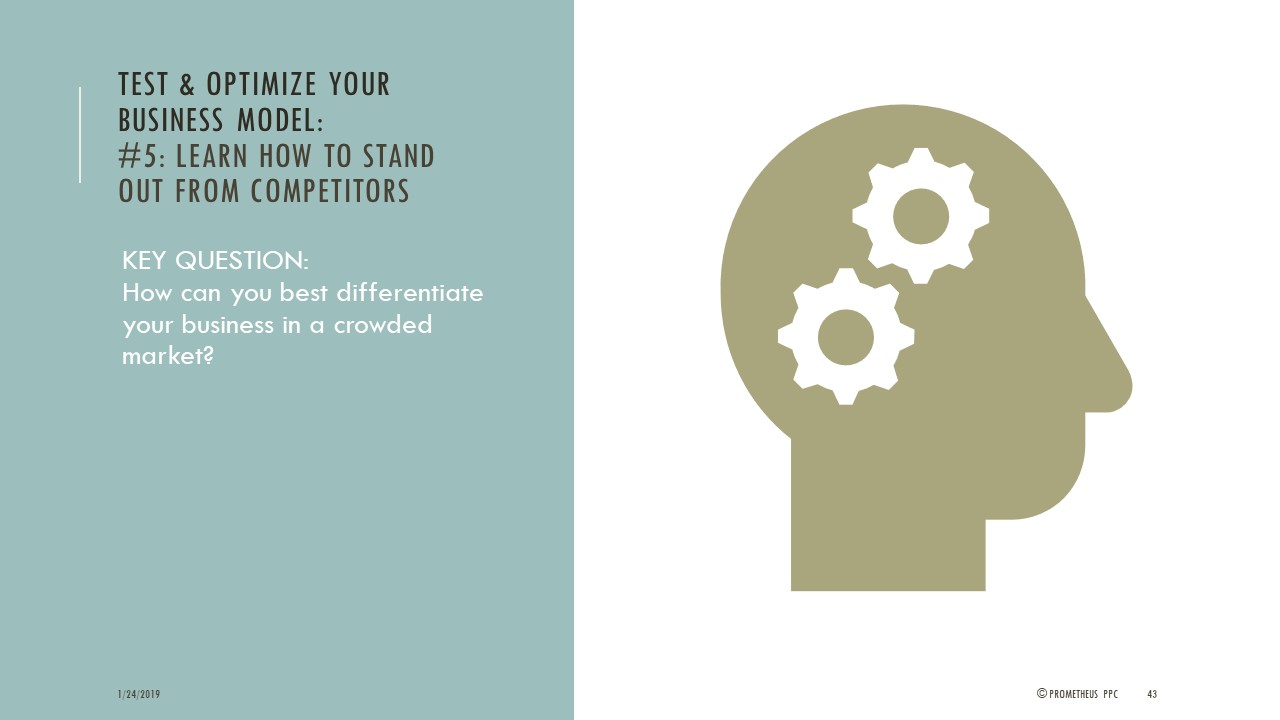How to Beat the Competition with Google Ads

MIT Presentation (part 6 of 8): Learn How to Stand Out from Competitors in Google Ads
Find your actual online competitors using the Google Ads Auction Insights report. Then research their ads with additional tools so that you can craft messaging that attracts your ideal prospects by focusing on your uniqueness and strengths.
This presentation was delivered by Prometheus PPC founder, Andrew Percey, on MIT campus in Cambridge, MA, on January 24, 2019, as part of “The Startup Code 2019” marketing seminar, which he organizes and co-hosts with serial entrepreneur Kenny Goodman. The attendees were MIT alumni, faculty, grad students and other members of the MIT community.
While this presentation includes specific advice for startups, the advanced strategies & tactics described can be used by any business that is looking to refine or troubleshoot their business model and marketing plan.
Video (part 6 of 8)
PDF slides (part 6 of 8)
Links to all posts in this presentation series, including videos, slides & transcripts:
- Full Presentation: 5 Ways to Test & Optimize your Business Model with Google Ads
- Introduction: What is Google Ads and Why Use It?
- How to test & optimize your prospect targeting, messaging and sales flow:
- Method #1: Learn Your Available Prospect Volume with Google Ads
- Method #2: Learn What Your Google Ads Prospects Actually Search For
- Method #3: Learn Which Marketing Messages Engage Your Google Ads Prospects
- Method #4: Learn Which Business Offers Resonate with Your Google Ads Prospects
- Method #5: Learn How to Stand Out from Competitors in Google Ads
- Conclusion: Best Google Ads First Steps Plus Tools & Resources
- Q&A: Google Ads Questions from Startup Founders
See all “Startup Code 2019” presentations and resources
See all MIT marketing seminars
Transcript of Presentation (part 6 of 8)
Method #5: Learn How to Stand Out from Competitors in Google Ads
And the last way I want to talk about to test and optimize your business model is to find out how can you best differentiate your business in a crowded market? How can you stand out against all those other ads that people see? Sam Altman says, “Move fast. Speed is one of your main advantages over large competitors.” And your differentiator is a great way to do that because big companies can’t change their benefits and features and differentiators so quickly. You probably can.
The first step is to find out who your online competitors are. And Google has a fantastic tool for that within Google ads. It’s called the Auction Insights Report. Down the left hand side, those are all different companies that are advertising on your keywords. And it tells you what percentage of the searches their ads also show up on, in what position on the page their ads, on average, show up. Again, for your keywords that you’re targeting, how often you overlap with those ads. And the outranking share is how often your ad appears above theirs, or appears when theirs don’t. So right here, this gives you a great snapshot of who you’re actually competing against, and where you fall in the pecking order for the keywords that you’re targeting. In this case, Amazon is the big Goliath in the room, almost always showing above our particular ad.
Once you have this information, then you can go back to other tools to research these competitors. This again is going back to SEMRush, the tool I used before to extract those iRobot ads. They give you ad information, keyword information, a lot of additional competitive research to see everything that they’re doing once you know that this is your competitor to help you figure out how can I sound different? How can I make my ads different, my offer different? How can I compete against this giant company. And to do that, you’ve got to find a way to stand out.
You can also see this information inside Google ads. There’s yet another tool, the Google Ads Ad Preview and Diagnosis Tool. It looks just like a regular search results page but happens inside the tool, and it’s better because it lets you control things like location, device, language and audience as you figure out who is competing with you. And then again, look at their ads. I think iRobot did a very smart thing here. They’re competing against Amazon, so their ad says, “If it’s not from iRobot, it’s not a Roomba.” What a great way to put it in your mind that you should buy from them instead of Amazon. I bet they did some competitive research to figure this out.
And that’s the sort of thing you want to be thinking about too. If your ad looks just like everyone else’s, I mean, really, why would someone click on it? You have to give them a reason. And if that is the case, if you find that your ad sounds just like everyone else’s, what can you do? Well, I suggest focus on one meaningful differentiator, because honestly, your offer can be identical in every way, except one. As long as there’s one difference that’s meaningful to your ideal prospects, that’s enough to connect and get them to click through. For example, if your offer is just like Amazon’s, but you can offer a full lifetime warranty, while they can’t – that can be enough to win business through your website against Amazon.
Additionally, it almost always works better to speak directly to a single niche instead of speaking generally. For example, if you’re looking for a Ruby on Rails developer, and you see an ad come up that says “Ruby on Rails developers” next to another ad that says “Broad range of developers”, obviously, which one are you going to click on? You get much better results when you can be more specific, targeting your niche audience.

Very informative article, thanks for sharing about competitors with google ads